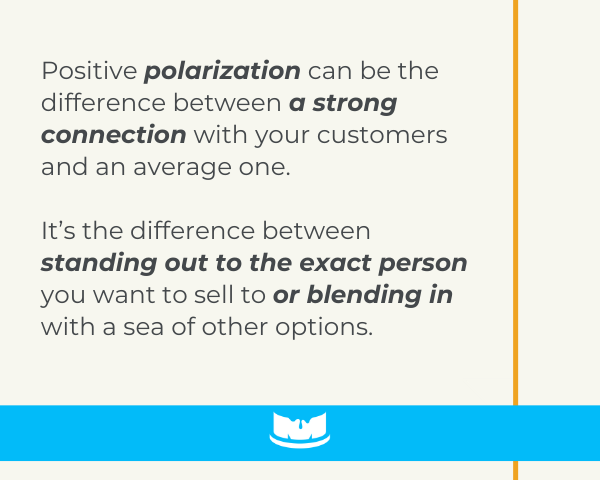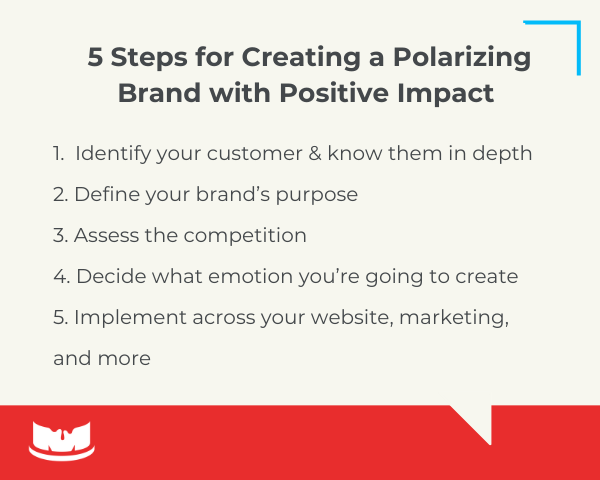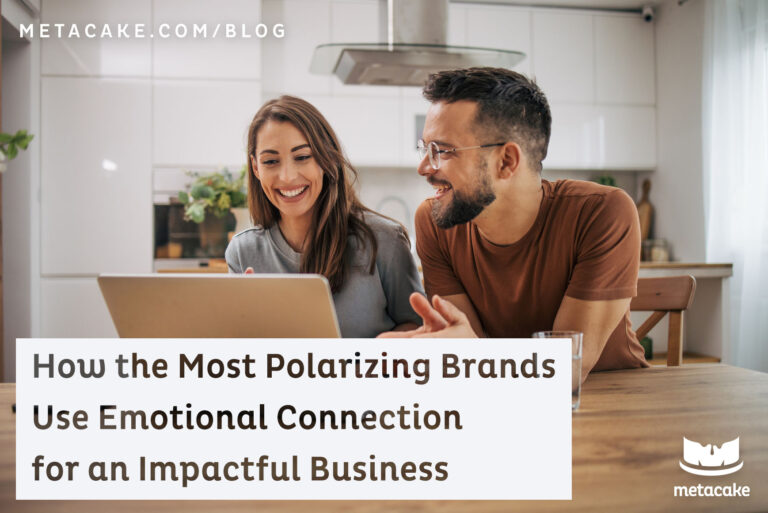Are you looking to create a business with raving fans who will be loyal to your company for years to come? You will need to start with creating a polarizing brand.
If that sounds surprising, think of all the top brands, or even celebrities or public figures, who you really love. Does anyone dislike them as much as you love them? The answer is most likely yes. That is brand polarization at work, and it’s a by-product of successful branding and marketing.
Now sometimes, this can have a downside. There are brands and individuals who polarize on purpose with the intention of creating division and hurting people. That is not the brand polarization definition we are talking about here.
We are here to discuss positive brand polarization, which is rooted in the truth that in order to be passionately cared about by customers you must be specific about who you are, why you do what you do, and how you market your brand. That level of specificity will inevitably cause some to say “that’s definitely not for me”. But that specificity will also strongly resonate with others, generating positive feelings that drive action. It will establish a brand emotional connection, and create raving brand fans for life.
In this post, we’ll discuss five steps to build positive polarization into your brand so that you can establish an emotional connection with your customers, become an influential brand, and ultimately, grow a more profitable business.
An Important Mindset Shift for Business Owners
Before we get started, it’s important to recognize that owning a business is a calling. It has to be, because building a profitable ecommerce business takes a significant amount of thought, strategy, planning, and hard work.
Just about anyone can put together an online shop that drop-ships from a different country, powered by growth hacking tips from YouTube. Some might see a bit of success. But most likely, these will be a flash in the pan.
Building a real business that is long lasting and valuable takes hard, thoughtful work. It also takes risk and investment. You’ll need to build something memorable and make an impact. If you’re just like everyone else, it will be very difficult to get any real momentum.
Definition of Brand Polarization
So, if you want to build something that is truly memorable, we need to understand the true brand polarization definition— what it is and what it isn’t.
Brand polarization is essentially choosing a group of ideal customers and tailoring everything about your brand, product, and marketing to serve them very specifically. Think of it like defining a niche and then investing in it.
Brand polarization is not about trying to be offensive or divisive on purpose.
Most polarizing brands are simply serving a specific group and tailoring what they do to those customers’ pain points and desires. They’ve learned to speak their customers’ language and how to create a brand emotional connection with this particular group.
This might make some people not like them, because what they offer or communicate doesn’t resonate with everyone. Some might even adamantly disagree with their approach. But at the end of the day, criticism from people who aren’t actually your customers is worth it, if it means getting to build a base of loyal fans who are your customers for life. That fan base will be immensely valuable for your brand.
Why Is Feeling Neutral About a Brand Worse Than Hating It?
The idea of some people disagreeing with, disliking, or even hating your brand might sound risky. But believe it or not, this is actually better than the general population being neutral to your brand.
Studies show that the primary deciding factor that makes someone actually press that “purchase” button is how the customer feels—their emotions. Information and logic are important for building a case for the purchase and building trust, but when it comes down to it, people only buy if they feel like it.
So what makes someone feel like buying? An emotional connection with your brand. Positive polarization is the way to foster those emotions in your site visitors and potential buyers. In this way, it ends up being extremely helpful – even necessary – for brands. It will be the difference between a strong connection and an average one. It’s the difference between standing out to the exact customer you want to sell to, or blending in with a sea of other options.

Examples of Brands Using Positive Polarization
Before we get into five steps to incorporate positive polarization in your brand, let’s take a look at just a few examples of familiar brands you might not have realized are already implementing this in their brand and marketing strategies. You’ll find that many of the most polarizing brands are actually using polarization for good – not for division – and have become highly influential as a result.
Apple
When Apple began, they said they would focus on simplicity and design — even though they operate in an industry that was highly complex. At the time, this was a unique move and was actually polarizing. Some consumers were thrilled, while others hated the idea. Even today, as big as Apple has become, there are still die-hard Apple fans, and then those who wouldn’t want to use an iPhone if it was handed to them for free. The key to maintaining that fan base is the emotional connection fans have with the brand, and the strong desire customers feel to get to experience all of their products in their daily lives.
Ramsey Solutions
Dave Ramsey’s financial advice and products are built on the philosophy that “debt is dumb and cash is king”. Their approach to building wealth stays far away from credit cards and loans, and only spending cash you have. Not everyone agrees with this approach, and there are surely critics of their brand. But, more importantly, there are millions of customers who love this system because it works for them. They have the success stories to prove it, and they are fans for life. The result? An incredible business with lasting impact.
CrossFit
CrossFit gyms and their methods are another example of a polarizing brand. Their high-intensity workouts and competitive atmosphere has fostered a devoted community of people who are proud to be “CrossFitters”. At the same time, that intensity has also drawn criticism from those who either disagree with this approach to fitness, or who view the gym and its following as extreme or even “cult-like”. Regardless of those opinions, CrossFit continues to thrive thanks to its passionate customer base.
Liquid Death
This beverage company’s hero product is canned water, but they are anything but boring. With bold messaging, edgy design, and innovative ad campaigns, their style and voice is strategically positioned to resonate with a certain audience. Their extreme edge does not fit every consumer’s style, but for those that it does — they are all in on this brand.
5 Steps for Creating a Polarizing Brand with Positive Impact
Ready to learn how to implement the power of polarization in your own brand? Let’s get into 5 steps the most polarizing brands have used to make this happen.

Step 1: Identify Your Customer and Know Them in Depth
If you have not already, it is time to establish customer avatars for your business. This is an important branding exercise in which you establish who your primary customers are, and then get to know them in depth. This goes beyond standard demographics and into psychographics— identifying their pain points, goals, wants, needs, and psychology behind what they buy and why. Most brands have at least two avatars, but some can have five to ten.
If you can do this, then you can align your branding and marketing with your customer, setting everything up to serve them at a deep level. This step is basically deciding who you are fighting for and why, and draw a line in the sand.
Step 2: Define Your Brand’s Purpose
What you sell is not nearly as important as why you sell it. Positive polarization comes from the reason you created your product, why you’re serving your particular customer, and why your customers need and want your product.
The deeper and more real you can get in identifying and developing your purpose, the easier it will be to establish polarization and to effectively market and sell your product. This purpose is what will create an emotional connection with your customers and compel them to choose you instead of your competition.
Keep in mind, your “why” does not have to be philanthropic or charitable. It just needs to be genuine. For more on how to dig into your purpose and define your “why” (which is a valuable business asset!), click here.
Step 3: Assess the Competition
The next step is to take inventory of your competition. Identify what other options are out there and what your ideal customers are doing to solve their needs or address their pain points. What methods are your competitors doing to solve this?
Then, establish how your brand will address these unique customers’ needs differently. Ask yourself:
- How can we offer something different?
- Why is that the right way for our chosen customers, and why is our competitors’ offer the wrong way for these specific buyers?
- Why might we be wrong for people who aren’t our chosen customers?
Remember, you’re not trying to be right for everyone. You’re just trying to be very much right for your chosen customer avatars.
Step 4: Decide What Emotion You’re Going to Create
As we mentioned above, your customers’ feelings are going to be the deciding factor on what to buy, where they’ll buy from, and when they’ll click “purchase”. Emotions drive action. This is true no matter what product you’re selling — from luxury cars to insurance to fashion to digital products.
What many brands don’t realize is that the emotion they create in their customers can (and should) be strategic. The most successful brands you can think of all decided what emotion they wanted their customers to feel when shopping their site or watching their ads. Whether that was a feeling of joy, excitement, adventure, comfort, nostalgia, or even fear, that was curated on purpose.
So ask yourself, what emotion do you want your customers to feel? What will be the most compelling and incentivizing for them to purchase the solution you’re offering?
Step 5: Put This Into Action
Now it’s time to incorporate your “why”, your story, and those emotions into your entire business. This is a great opportunity to create a strong “About Us” page on your site, but your purpose really needs to shine through in many more ways than that. Look for opportunities to build it into messaging on your homepage and product pages. Tell the story throughout your email welcome flow, and in regular email campaigns. Incorporate it into ad copy as well.
Remember, having a strong “why” does not necessarily mean you have to be altruistic. Your purpose can be simple and still be powerful. It just needs to be genuine, communicated in a way that aligns well with your brand voice, and evoke the feelings you decided to create.
Using Brand Polarization for Good
Becoming a polarizing brand should not have a negative result on society. It is possible to be polarizing in a positive way, especially when it’s centered on serving a select group of customers better than anyone else in the marketplace.
Being a brand with influence over consumers’ emotions and spending comes with responsibility. But when using your powerful psychological tools wisely and ethically, this can be used to create a positive impact on the world—and to create a long-lasting, successful ecommerce business.
